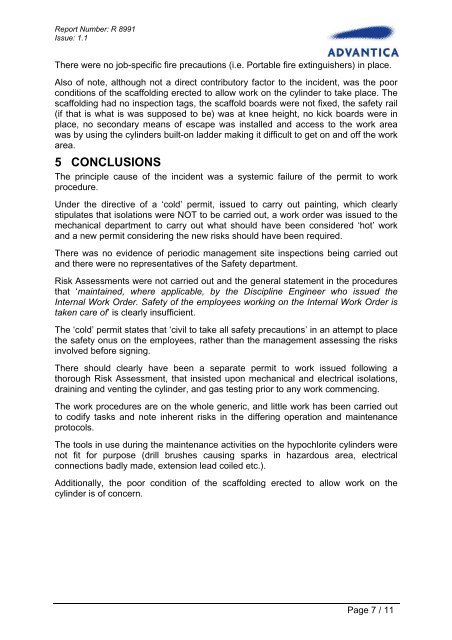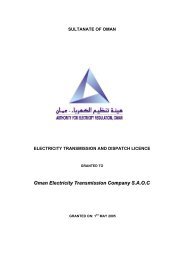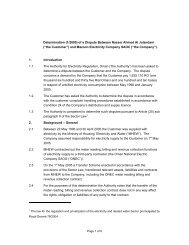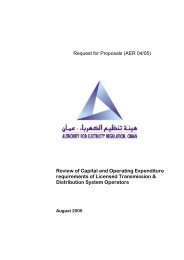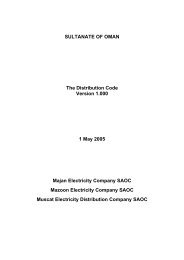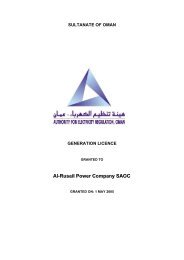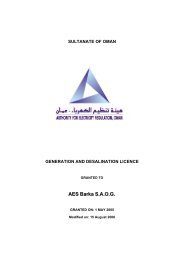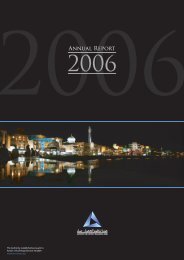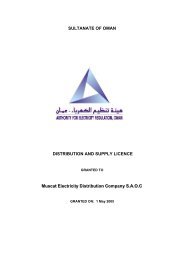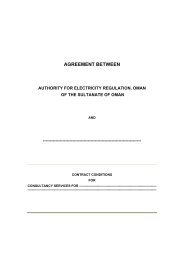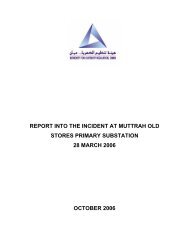GhubrahIncidentInves.. - authority for electricity regulation, oman
GhubrahIncidentInves.. - authority for electricity regulation, oman
GhubrahIncidentInves.. - authority for electricity regulation, oman
Create successful ePaper yourself
Turn your PDF publications into a flip-book with our unique Google optimized e-Paper software.
Report Number: R 8991<br />
Issue: 1.1<br />
There were no job-specific fire precautions (i.e. Portable fire extinguishers) in place.<br />
Also of note, although not a direct contributory factor to the incident, was the poor<br />
conditions of the scaffolding erected to allow work on the cylinder to take place. The<br />
scaffolding had no inspection tags, the scaffold boards were not fixed, the safety rail<br />
(if that is what is was supposed to be) was at knee height, no kick boards were in<br />
place, no secondary means of escape was installed and access to the work area<br />
was by using the cylinders built-on ladder making it difficult to get on and off the work<br />
area.<br />
5 CONCLUSIONS<br />
The principle cause of the incident was a systemic failure of the permit to work<br />
procedure.<br />
Under the directive of a ‘cold’ permit, issued to carry out painting, which clearly<br />
stipulates that isolations were NOT to be carried out, a work order was issued to the<br />
mechanical department to carry out what should have been considered ‘hot’ work<br />
and a new permit considering the new risks should have been required.<br />
There was no evidence of periodic management site inspections being carried out<br />
and there were no representatives of the Safety department.<br />
Risk Assessments were not carried out and the general statement in the procedures<br />
that ‘maintained, where applicable, by the Discipline Engineer who issued the<br />
Internal Work Order. Safety of the employees working on the Internal Work Order is<br />
taken care of’ is clearly insufficient.<br />
The ‘cold’ permit states that ‘civil to take all safety precautions’ in an attempt to place<br />
the safety onus on the employees, rather than the management assessing the risks<br />
involved be<strong>for</strong>e signing.<br />
There should clearly have been a separate permit to work issued following a<br />
thorough Risk Assessment, that insisted upon mechanical and electrical isolations,<br />
draining and venting the cylinder, and gas testing prior to any work commencing.<br />
The work procedures are on the whole generic, and little work has been carried out<br />
to codify tasks and note inherent risks in the differing operation and maintenance<br />
protocols.<br />
The tools in use during the maintenance activities on the hypochlorite cylinders were<br />
not fit <strong>for</strong> purpose (drill brushes causing sparks in hazardous area, electrical<br />
connections badly made, extension lead coiled etc.).<br />
Additionally, the poor condition of the scaffolding erected to allow work on the<br />
cylinder is of concern.<br />
Page 7 / 11


